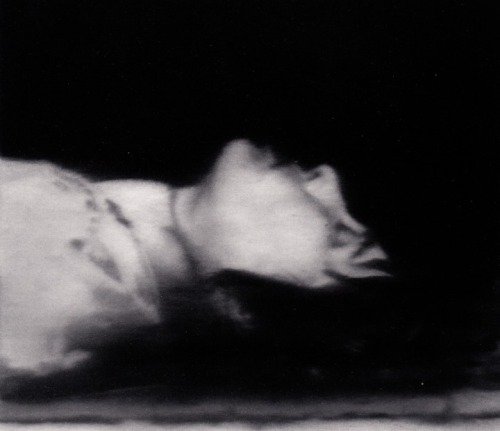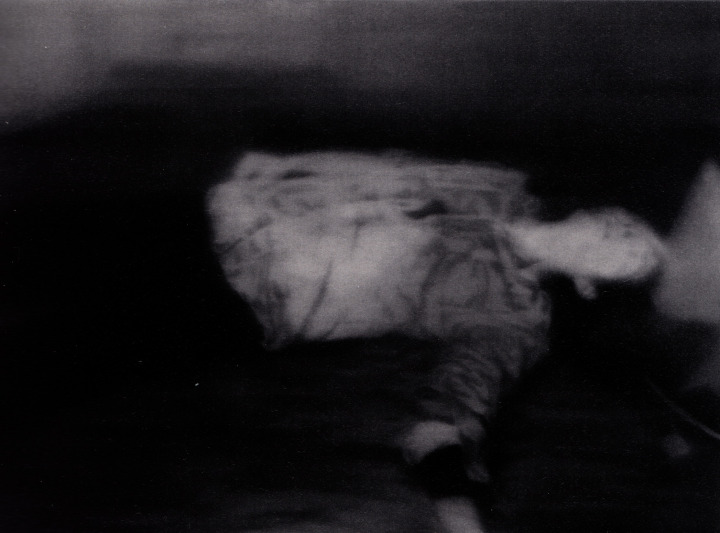
She knew there was someone else in the room. There was no outright noise, just an intimidation behind her, a faint displacement of air. She’d been alone for a time, seated on a bench in the middle of the gallery with the paintings set around her, a cycle of fifteen canvases, and this is how it felt to her, that she was sitting as a person does in a mortuary chapel, keeping watch over the body of a relative or friend.
This was sometimes called the viewing, she believed.
She was looking at Ulrike now, head and upper body, her neck rope-scorched, although she didn’t know for certain what kind of implement had been used in the hanging.
She heard the other person walk toward the bench, a man’s heavy shuffling stride, and she got up and went to stand before the picture pof Ulrike, one of three related images, Ulrike dead in each, lying on the floor of her cell, head in profile. The canvases varied in size. The woman’s reality, the head, the neck, the rope burn, the hair, the facial features, were painted, picture to picture, in nuances of obscurity and pall, a detail clearer here than there, the slurred mouth in one painting appearing nearly natural elsewhere, all of it unsystematic.
“Why do you think he did it this way?”
She did not turn to look at him.
“So shadowy. No color.”
She said, “I don’t know,” and went to the next set of images, called Man Shot Down. This was Andreas Baader. She thought of him by his full name or surname. She thought of Meinhof, she saw Meinhof as first name only, Ulrike, and the same was the case with Gudrun.
“I’m trying to think what happened to them.”
“They committed suicide. Or the state killed them.”
He said, “The state.” Then he said it again, deep-voiced„ in a tone of melodramatic menace, trying out a line reading that might be more suitable.
She wanted to be annoyed but felt instead a vague chagrin. It wasn’t like her to use this term – the state – in the ironclad context of supreme public power. This was not her vocabulary.
The two paintings of Baader dead in his cell were the same size but addressed the subject somewhat differently, and this is what she did now – she concentrated on the differences, arm, shirt, unknown object at the edge of the frame, the disparity or uncertainty.
“I don’t know what happened,” she said. “I’m only telling you what people believe. It was twenty-five years ago. I don’t know what it was like then, in Germany, with bombings and kidnappings.”
“The made an agreement, don’t you think?”
“Some people believe they were murdered in their cells.”
“A pact. There were terrorists, weren’t they? When they’re not killing other people, they’re killing themselves.” he said.
She was looking at Andreas Baader, first one painting, then the other, then back again.
“I don’t know. Maybe that’s even worse in a way. It’s so much sadder. There’s so much sadness in these pictures.”
Don DeLillo,1936. Baader-Meinhof, in, The Angel Esmeralda: Nine Stories, 2011. First published as Baader-Menhof, in The New Yorker, April 1st 2002
Images: Gerhard Richter, b.1932. Man Shot Down 2 (Erschossener 2), 1988. Oil on Canvas, 100.5 x 140.5 cm
Gerhard Richter, b.1932. Dead (Tote), 1988. Oil on canvas, 62 x 73 cm
© MoMA, New York. The Sidney and Harriet Janis Collection, gift of Philip Johnson, and acquired through the Lillie P. Bliss Bequest (all by exchange); Enid A. Haupt Fund; Nina and Gordon Bunshaft Bequest Fund; and gift of Emily Rauh Pulitzer
The short story describes a series of fifteen paintings entitled, October 18, 1977, by Gerhard Richter, born 1932, now in MoMA, New York. Text from: Gallery label from Out of Time: A Contemporary View, August 30, 2006–April 9, 2007. The fifteen paintings that compose October 18, 1977 are based on photographs of moments in the lives and deaths of four members of the Rote Armee Fraktion (RAF), a German left-wing terrorist group that perpetrated a number of kidnappings and killings throughout the 1970s. . . . these paintings have a single date as their title. On this date the bodies of three principal RAF members were found in the cells of the German prison where they were incarcerated. Although the deaths were officially deemed suicides, there was widespread suspicion that the prisoners had been murdered by the German state police. Richter based his paintings on newspaper and police photographs; his reworking of these documentary sources is dark, blurred, and diffuse. Richter hopes that, “by way of reporting,” these paintings will “contribute to an appreciation of [our time], to see it as it is.”

You must be logged in to post a comment.